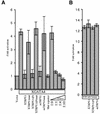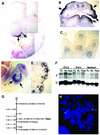Transcriptional repression and developmental functions of the atypical vertebrate GATA protein TRPS1
- PMID: 11285235
- PMCID: PMC145487
- DOI: 10.1093/emboj/20.7.1715
Transcriptional repression and developmental functions of the atypical vertebrate GATA protein TRPS1
Abstract
Known vertebrate GATA proteins contain two zinc fingers and are required in development, whereas invertebrates express a class of essential proteins containing one GATA-type zinc finger. We isolated the gene encoding TRPS1, a vertebrate protein with a single GATA-type zinc finger. TRPS1 is highly conserved between Xenopus and mammals, and the human gene is implicated in dominantly inherited tricho-rhino-phalangeal (TRP) syndromes. TRPS1 is a nuclear protein that binds GATA sequences but fails to transactivate a GATA-dependent reporter. Instead, TRPS1 potently and specifically represses transcriptional activation mediated by other GATA factors. Repression does not occur from competition for DNA binding and depends on a C-terminal region related to repressive domains found in Ikaros proteins. During mouse development, TRPS1 expression is prominent in sites showing pathology in TRP syndromes, which are thought to result from TRPS1 haploinsufficiency. We show instead that truncating mutations identified in patients encode dominant inhibitors of wild-type TRPS1 function, suggesting an alternative mechanism for the disease. TRPS1 is the first example of a GATA protein with intrinsic transcriptional repression activity and possibly a negative regulator of GATA-dependent processes in vertebrate development.
Figures







References
-
- da Costa L.T., He,T.C., Yu,J., Sparks,A.B., Morin,P.J., Polyak,K., Laken,S., Vogelstein,B. and Kinzler,K.W. (1999) CDX2 is mutated in a colorectal cancer with normal APC/β-catenin signaling. Oncogene, 18, 5010–5014. - PubMed
-
- Deconinck A.E., Mead,P.E., Tevosian,S.G., Crispino,J.D., Katz,S.G., Zon,L.I. and Orkin,S.H. (2000) FOG acts as a repressor of red blood cell development in Xenopus. Development, 127, 2031–2040. - PubMed
-
- Fukushige T., Hawkins,M.G. and McGhee,J.D. (1998) The GATA-factor elt-2 is essential for formation of the Caenorhabditis elegans intestine. Dev. Biol., 198, 286–302. - PubMed
-
- Georgopoulos K., Winandy,S. and Avitahl,N. (1997) The role of the Ikaros gene in lymphocyte development and homeostasis. Annu. Rev. Immunol., 15, 155–176. - PubMed
Publication types
MeSH terms
Substances
Associated data
- Actions
- Actions
- Actions
Grants and funding
LinkOut - more resources
Full Text Sources
Other Literature Sources
Molecular Biology Databases
Research Materials

